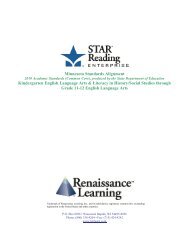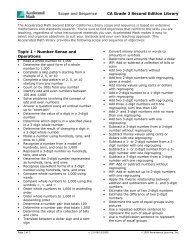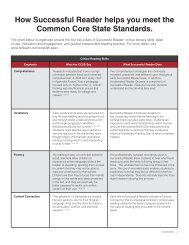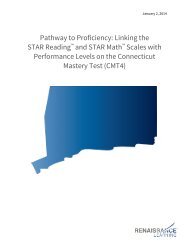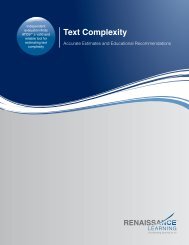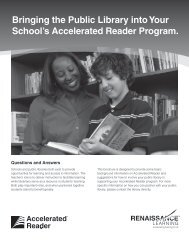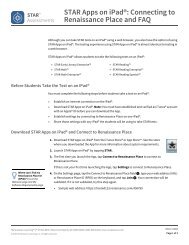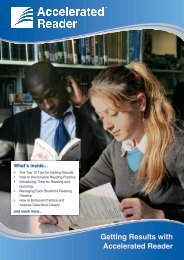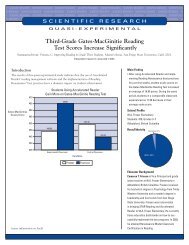Technical Manual - Renaissance Learning
Technical Manual - Renaissance Learning
Technical Manual - Renaissance Learning
Create successful ePaper yourself
Turn your PDF publications into a flip-book with our unique Google optimized e-Paper software.
STAR Early Literacy Enterprise in the ClassroomApproaches and Rationales for Recommended UsesEmergent readers can relate pictures to words. These students are beginning torecognize and tell the difference between words and letters. They can probablyrelate some letters with their sounds and are likely beginning to separate spokenwords into individual units of sound.At the Late Emergent Reader stage, students can identify most of the letters of thealphabet and can match most of the letters to their sounds. They are beginning to“read” picture books and familiar words around their home. Through repeatedreading of favorite books with an adult, children at this stage are building theirvocabularies, listening skills, and understanding of print. Late Emergent Readerscan recognize some printed words in their surroundings, including signs and theirnames. They are also learning to separate spoken words into smaller parts, suchas m- and -at for “mat.” Late Emergent Readers are probably beginning to “soundout” simple printed words and are starting to get meaning from text with theirgrowing knowledge of letter sounds and word structure.Students at the Transitional Reader stage have mastered their alphabet skills andletter-sound relationships. They can identify many beginning and endingconsonant sounds and long and short vowel sounds. Students at this stage aremost likely able to blend sounds and word parts to read simple words. They arelikely using a variety of strategies to figure out words, such as pictures, storypatterns, and phonics. Transitional Readers are generally starting to apply basicconcepts about print and books to unfamiliar text. Students at this stage arebeginning to read unfamiliar words and easy-reader material, but are not yetfluent, independent readers.Students at the Probable Reader stage are becoming proficient at recognizingmany words, both in and out of context. They spend less time identifying andsounding out words and more time understanding what they have read. They canblend sounds and word parts to read words and sentences more quickly,smoothly, and independently. Probable Readers are starting to challengethemselves with longer picture and chapter books. They are increasingly able toselect books that interest them, to monitor their own reading, and to self-correctas needed. Probable Readers are generally able to read silently and to read aloudsome easy texts with accuracy, fluency, and expression.Screening AssessmentSTAR Early Literacy Enterprise can be used in several ways as a screeninginstrument as recommended by No Child Left Behind. The purpose of screening isto identify children who are at risk for delayed development or academic failureand who require additional reading instruction or further diagnosis. STAR EarlyLiteracy Enterprise can also be used for this further diagnosis.STAR Early Literacy<strong>Technical</strong> <strong>Manual</strong>117





